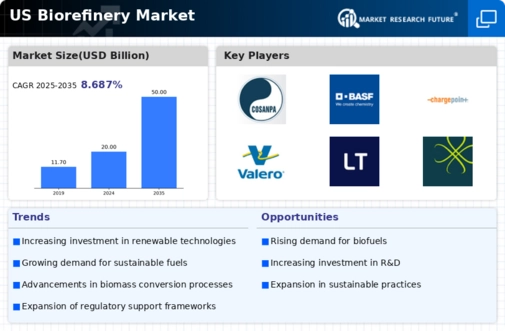The US Biorefinery Market is characterized by a competitive landscape that is influenced by various renewable and sustainable energy initiatives aimed at reducing dependence on fossil fuels. The market has seen significant growth due to increasing demand for biofuels and bioproducts, aligning with environmental regulations and the push for cleaner energy sources. Key players in the industry are focusing on technological advancements, innovative processes, and strategic partnerships to enhance their product offerings and market reach. Companies are also investing in research and development to optimize biorefining processes, improve efficiency, and lower production costs.
The competitive dynamics are further shaped by the growing emphasis on sustainability, which not only drives innovation but also encourages the emergence of new entrants in the market, creating a challenging environment for established firms that must continually adapt to evolving consumer demands and regulatory frameworks.Abengoa Bioenergy has established a strong foothold in the US Biorefinery Market, leveraging its advanced technology and expertise in the development of renewable energy solutions. The company has been a pioneer in creating efficient biorefining processes that convert biomass into a variety of biofuels and bioproducts.
One of Abengoa's significant strengths lies in its ability to integrate production processes, which enhances profitability and adaptability to market changes. The company's commitment to innovation is evident in its research initiatives aimed at optimizing biomass feedstock utilization and improving overall plant efficiency. Abengoa's significant investment in large-scale biorefineries in the United States demonstrates its confidence in long-term growth, which further solidifies its position in the competitive landscape.
Through strategic partnerships and collaborations, Abengoa is well-positioned to respond effectively to market demands and environmental sustainability goals.Cosan is another prominent player in the US Biorefinery Market, recognized for its comprehensive portfolio of biofuels and agricultural products. The company focuses on producing ethanol and other bio-based products through its advanced biorefinery technologies. Cosan’s key offerings include sugarcane-based ethanol, which is increasingly sought after due to its sustainability credentials. The company has made significant strides through strategic mergers and acquisitions, enhancing its market presence and operational capabilities in the US.
By optimizing supply chains and production processes, Cosan has strengthened its competitive position, facilitating efficient distribution and consistent product quality. With a focus on sustainability and innovation, Cosan also invests heavily in research and development, ensuring that it remains at the forefront of biorefinery advancements. Its established network and strong operational expertise underscore its commitment to serving the renewable energy sector effectively while capitalizing on the growing demand for biofuels in the United States.






















Leave a Comment